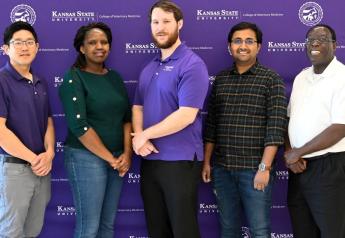Overcooking Pork Should be a Rare Occurrence

By Janeal Yancey
In 2011, the USDA officially changed their recommendation for cooking whole muscle pork cuts from a final end-point temperature of 160°F (medium degree of doneness) to 145°F with a 3-minute rest (medium-rare). As a meat scientist with a love for medium-rare cuts, I was eager to give the new recommendation a try on a thick-cut pork chop.
U.S. pork has been free from the trichinae parasite for years. Sadly, the fear of this parasite caused our grandmothers to worry about eating undercooked pork and teach our mothers (who then taught us) to overcook pork. After generations of eating dry, well-done pork chops, I was excited to try them with a little pink in the middle. As I suspected, medium-rare pork chops were tender, juicy and very flavorful.
The Science Behind Tasty Pork Chops
Meat is largely composed of two major types of proteins: myofibrillar (proteins that do the work of muscle contraction) and connective tissue (proteins that hold muscle together). Heat has very different effects on those protein types. Myofibrillar proteins harden and toughen as temperatures rise; whereas connective tissue proteins gelatinize with increasing temperature.
When grilling cuts like loin chops and tenderloin, the amount of connective tissue is minimal, so they don’t need the long, slow cooking methods of ham and shoulder cuts. Loin chops benefit from a fast cookery method and an optimal medium-rare endpoint temperature.
Meat scientists are finding that degree of doneness is important when it comes to tenderness and juiciness. University of Illinois researchers have studied how cooking temperature and other factors affect tenderness and juiciness in pork chops. Time and time again, they found end point temperature was most important. Cooking to 145°F resulted in chops that were more tender and juicier than chops cooked to 160°F.
Scientists had people taste the chops and rate them on tenderness and juiciness, and they measured chop tenderness using instrumental means. Each time, chops cooked to medium-rare were more tender and juicier. Researchers looking at the effects of marbling, packaging and fresh color found none of these were as important to tenderness as degree of doneness.
The Chefs Agree
Some might argue the pink color of medium-rare pork chops is off-putting. In research studies, panelists usually eat the chops in rooms with adjusted lighting so the pink color will not bias ratings. In unofficial, non-scientific tests in our kitchen, cooking to 150°F helps lessen pink color while maintaining tenderness.
As a scientist, I believe more research will help us better understand the optimal cooked temperature for acceptable cooked color and tenderness for consumers.
Try cooking pork chops medium-rare. In a National Pork Board article, celebrity chef Guy Fieri says home cooks could now feel confident serving medium-rare pork as chefs had been serving it that way for years.
Related Articles:
Meat Has a Replacement But No One Knows What to Call It
Janeal Yancey grew up in Texas showing pigs in FFA. She became interested in meats through FFA and collegiate meat judging at Texas Tech University. Her doctoral research at Kansas State University focused on improving pork quality. She teaches and conducts research on meat quality at the University of Arkansas. On her “Mom at the Meat Counter Blog,” she shares her point of view as a mom, cattle producer and meat scientist. She and her husband, Ed, also a meat scientist, have two daughters, Vallie and Wyn.







